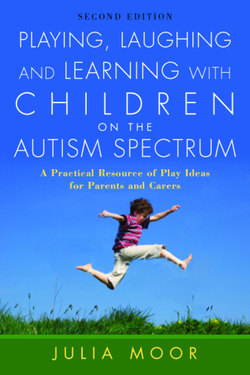Читать книгу Playing, Laughing and Learning with Children on the Autism Spectrum - Julia Moor - Страница 17
На сайте Литреса книга снята с продажи.
Chapter 3 Structured Play Why do children on the autism spectrum need structure?
ОглавлениеDespite common communication impairments, children on the autism spectrum vary considerably, in fact autism may be seen as an ‘umbrella’ term in itself, like the description ‘learning disability’. As autism does not just affect the ability to learn and understand but affects processing by all the senses, the potential for its various subtypes is endless – different degrees of problems with speech, social communication, learning difficulties, sensory problems, physical problems…, and on top of this are the individual’s responses and ability to cope with his condition.
As much as we all hate labels, for most parents the diagnostic label should be the passport to relief, to being able to find the most appropriate services, the right professional help and the best approach for them and their child. Confusingly, however, for parents of children on the autism spectrum there doesn’t seem to be one best approach. There are a number of routes all with worldwide advocates who devoutly believe that this is the only way to help, if not ‘recover’, your child from autism. For parents of very young children, this diversity of advice is confusing, pressurizing and piles more stress on top of an already strained household.
Despite this barrage of what seems like contradictory advice there are some golden threads of agreement and one such element is that of structure. It would appear that those therapies and approaches to autism that have stood the test of time and demonstrated quantifiable results have a central theme of structure. In describing what structure is, it is probably easier to describe what structure isn’t, with all the contradictions that this encompasses!
It isn’t about providing a great deal of choice (though creating opportunities for choice is a part of structuring the environment).
It isn’t about ‘free’ play (though structured play is the first step to encouraging spontaneous play).
It isn’t about leaving a child to discover an activity, its limits and potentials by himself (though learning to discover these things together is a definite goal).
It isn’t about these things because, in a play context, choice, freedom and discovery are simply not the things that motivate children with autism to play in the way they motivate their non-autistic peers. Children with autism need structure because despite their many differences, in general they have impaired motivation to interact, learn and play. They have rigid and repetitive patterns of thinking and therefore of talking and playing, and are often motivated to preserve ‘sameness’. Coupled with a resistance to being directed and a need to take control of as many aspects of their immediate environment as possible, it is not difficult to appreciate how being part of a learning and playing environment that advocates spontaneity, free choice and independent discovery simply is not appropriate for a child with autism.
